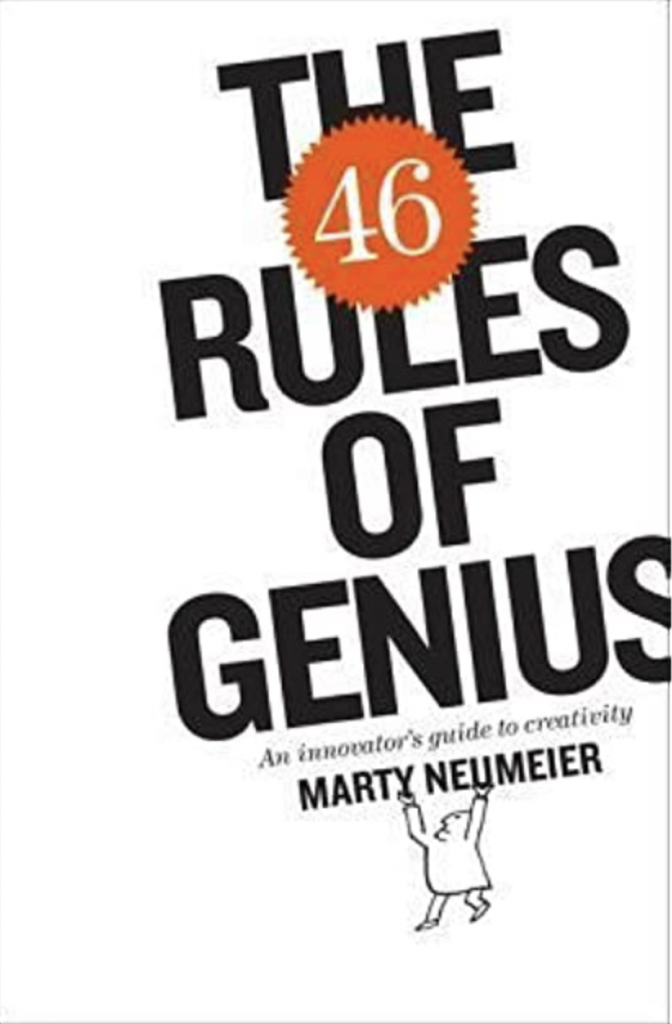Key Quote:
“The rules in this book are creative rules. They’re general guidelines to help you envision, invent, contribute, and grow” (pp. 7-8). — Marty Neumeier
Key Points:
Here is a sampling of the rules Neumeier proposes.
Rule 1: Break the Rules (The Genius Paradox)
“You have to disobey the rules of creativity to obey the rules of creativity. And in obeying the rules of creativity, you automatically disobey the rules of creativity. That’s because the number one rule is to break the rules” (p. 15).
To resolve the paradox: learn the rules, and decide to embrace or reject them. Observe the results. Rewrite the rules based on your experience (p. 15).
Rule 4: See What’s Not There
“Talent hits a target no one else can hit; genius hits a target no one else can see” – Arthur Schopenhauer (p. 8).
Always analyze the gaps or missing pieces in a system. See what is possible, not what is.
Every threat has the seeds of innovation.
Examine areas of uneven progress. New ideas always have resistance. Look for where these areas exist and find solutions for speeding up progress.
Evaluate how established norms will be changed by upcoming trends (pp. 21-22).
Rule 6: Frame Problems Tightly
Too much freedom leads to mediocrity, not genius. Boundaries and limits are necessary, or else there is no incentive to break them. “The greatest gift you can give a genius is limitation, not license” (p. 26). With too much freedom, results are unfocused, over-designed, out of budget, and overworked.
Never accept the problem as it is originally stated. Always probe deeper, because problems are often presented in faulty frameworks. Independently figure out the faulty assumptions about the problem, the direction of the project, and how success will be quantified (p. 23).
Rule 8: Stay in the Dragon Pit
The dragon pit is the place between what is and what could be. The dragons are symbols of uncertainty and discomfort. They are barriers between you and your most innovative thoughts. The longer you can stay in the dragon pit, the more “creative tension” you will build (p. 31).
Rule 9: Approach Answers Obliquely
If an answer is not surprising, it is not innovative, and it does not add value. Practice connecting unrelated ideas to prime your mind to see creative solutions.
Think in metaphors and pictures, reject the “right” solution and start problem-solving from a different angle, “steal from other domains,” “ask simple questions” about the big picture, and always record your thoughts.
“Reserve the polarity.” Write down all of your assumptions about the given problem. “Reverse” these assumptions and find out what it would take to make these new assumptions true.
Practice “combinatory play” by making a habit of combining two unlike combinations and see if this leads to a new idea (pp. 33-35).
Rule 12: Design Quickly, Decide Slowly
Most people learn and then do. Creatives learn, make, and then do. “Models, prototypes, or mockups” can be tested before they are selected. Making and experimenting with other solutions before doing allows you to design the path forward, creating your own options instead of using the ones that already exist (p. 44).
Rule 17: Match Form to Function, Function to Form
Sometimes function follows form, but regardless if form or function comes first, they should be inseparable. The shape of a design should always reflect the object’s or idea’s purpose (p. 56).
Rule 26: Start With Curiosity, not Belief
Real knowledge comes from the suspension of ideology. “Lean on belief only when necessary. And even then, think of belief as a placeholder for knowledge – not knowledge itself” (p. 84).
Rule 28: Keep a Hero File
Imitation is not the enemy of innovation. Creatives build on the work of others. Keep a file full of diverse influences. If you see something you wish you had made, copy it, photograph it, take notes, file it away, and eventually, all of these influences will merge into your own unique style. Steal principles of another’s work, but never the work itself (p. 88).
Rule 30: Learn Strategically
You can learn anything, but not everything. If you want to outrun the competition, you have to outlearn them. Your learning needs to strategically line up with your central purpose, which cannot happen if you are a random learner. It is important to seek knowledge across multiple domains, but first ask yourself, “Does your learning line up with your goals? Will it lead to fresh insights or deeper understanding?” (p. 92).
Rule 44: Join a Network
Creatives need support. The more knowledge they give to others, the more knowledge is given to them. “Genius is not so much something you have as much as something you do” (p. 135).Excellence blossoms in community.
Rule 46: Make New Rules
“The first rule of genius is to break the rules. The last rule is to replace them with your own rules – variations drawn from your own experience, aligned with your own style of working.” Remember that “all true invention, like all true art, is an act of protest, a rebellion against rules that have hardened into laws. Your job is to melt down the laws and recast them as principles that make sense to you, your discipline, and the needs of your work” (p. 140).
Neumeier, M. (2014). The 46 Rules of Genius: The Innovator’s Guide to Creativity. San Franciso, CA: New Riders.

“You have to disobey the rules of creativity to obey the rules of creativity. And in obeying the rules of creativity, you automatically disobey the rules of creativity. That’s because the number one rule is to break the rules.”
“The rules in this book are as timeless as they can be. None of them are new, yet they can help you create something new.”
“Always analyze the gaps or missing pieces in a system. See what is possible, not what is. Every threat has the seeds of innovation.”
